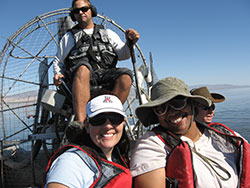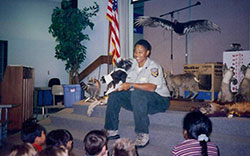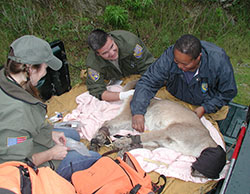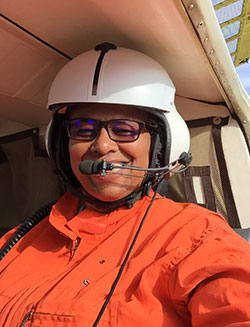
Chanelle part of team collecting diseased pelicans on Salton Sea.

Chanelle talking about wildlife at elementary school in Chino Hills.

Chanelle part of team examining mountain lion captured in La Canada and later released.

Chanelle on helicopter for Bighorn sheep survey in San Diego County.
Chanelle Davis is an environmental scientist in the Inland Desert Region. The Southern California native has been lucky enough to have worked her whole career in Southern California. Her first assignment was as the Los Angeles County Unit Manager, handling all the varied wildlife issues that come up in the most populated county in the state. Only a year into the job, she was the lead biologist for a controversial wildlife removal program in the town of Venice Beach when the local duck population was infected with Duck Viral Enteritis (DVE). She got a firsthand lesson in community relations and the emotions that run high for wildlife in the southland.
Chanelle is a graduate of California State Polytechnic University, Pomona, where she majored in zoology.
What’s a typical work day like?
Every day I log onto the computer and check emails and messages on the landline. If it is a scheduled office day, I might work on my database, read documents or work on reports. It’s typical to receive an email from someone regarding an issue they are having with wildlife. Depending on the problem, I might do a little research to make sure my info is up to date before contacting the reporting party. If it is a field day during study season, I meet my crew at the main office and head out to scope out, set up or monitor sites for the bear census we’re working on. Sometimes we get diverted to a new task like picking up a dead sheep and delivering it to the state lab or investigating a call about a sick animal that is in the vicinity. I get a lot of calls from the public regarding “where can I hunt?” or “what’s in my yard?” or “I have a bear, you need to move it.”
The bear census project sounds fascinating; how does that work?
It’s a non-invasive DNA black bear study using hair snares and in some instances camera traps. We erect a single strand barb wire corral in a pre-designated area. A brush pile is assembled in the middle of the corral and is sprayed with a non-consumable scent lure along with a lure rag that is suspended over the corral. Hopefully, a bear traveling through the area will find our scent interesting enough to come and investigate our brush pile and leave hair samples on the barb wire as it enters and exits the site. We also use “natural rubs” which are trees or poles where we find evidence of bear activity such as claw marks or deposits of hair. The hair is collected and submitted to a lab for DNA analysis. The analysis of the hair samples provides us with information regarding the number of bears that visited the site along with the frequency of the visits from a particular bear. Using this along with other data, we can get a general estimate of bears that call the San Bernardino Mountains home.
How is wildlife management in Southern California different from elsewhere in the state?
It often requires finesse and public interaction with local governments. We are very much in the public eye with news vans patrolling the street with their scanners, looking for an exciting story. Bears in pools and mountain lions in backyards are routinely shown on the news. Sometimes that is the first we hear of an encounter! The public has a different view of wildlife here, compared to some of the rural areas in the north. I believe the biggest difference can be seen in the handling of nuisance wildlife. Most cities in Southern California have ordinances against shooting a solid projectile within city limits, which pretty much excludes almost everything you can use to immediately deal with a number of nuisance wildlife issues. Even paintball guns are prohibited in some areas. “Hazing” is a tool that can be used to try to educate wildlife that being around people is not a good idea. In more rural areas, trained hounds can be used to achieve some of these goals, but due to the density of residences and major highways intersecting these city centers, using dogs is not an option here. What it boils down to is that we have to be very creative in our approach to help the public find solutions that protect property and allow wildlife to be wildlife.
For many years, you’ve helped teach the public how to accurately count sheep in our annual San Gabriel Mountains bighorn sheep survey. Is it difficult to explain scientific research to people who’ve never done this before?
I’ve been doing that presentation since 1992. The challenge is explaining why we’re doing this. It’s not just to have fun (though that’s a big part of it). The information they collect is needed in order to manage the species successfully. We have some volunteers who have never seen a bighorn sheep before! My part of the presentation is getting people comfortable with identifying sheep, and teaching them how to differentiate between males and females, adults and juveniles.
Do you have an example of a great CDFW day recently?
Recently, I was with my scientific aides Dylan and Mary, scoping out a potential snare site at Bluff Lake, a Wildlands Conservancy property in the San Bernardino Mountains. On our hike back to the truck, Dylan stopped and pointed and said, “Is that a bear?” Sure enough, about 50 feet away was a bear. Dylan had never seen a black bear this close and Mary had never seen a bear at all. We stopped and as the bear played peek-a-boo around a tree trunk, I suggested that we observe the bear and see what would happen. When the bear decided we were no longer interesting, it crossed the path and started digging in the moist soil. Dirt was flying everywhere! Then it moved on to the lake, where it proceeded to splash around and then float on its back and play with its paws. It ran up a tree and slid back down, and then climbed a different tree and started breaking off branches. Eventually it went back to the lake and swam to the opposite shore, heading back into the forest. We decided to investigate where the bear had crossed the trail. There was no print in the dirt where it crossed. We looked at the trees for claw marks. There were hardly any markings on the trunk. It was awesome to see the look of fascination and determination on the faces of Dylan and Mary. Although we all observed the bear, there was little evidence of its passage through the area. It was a great learning experience for all of us and it highlighted the fact that sometimes bears just want to have fun.
Do you share lessons with your scientific aides when doing research?
Yes, by impressing on them the importance of our tasks, the integrity of the data and taking pride in their work. Sometimes we can do everything right and still come up with nothing. Wildlife do not read our manuals nor do they care what the “model” predicts their habitat should be.
But there is more to it than that. Performing the same task day in and day out can get monotonous. There are days where things do not go as planned and it can get frustrating. I am a firm believer of having a positive outlook. At the end of every day we discuss the day’s events. It’s easy to come up with positives at the end of a great day, but to come up with positives on a day where things went sideways is a challenge. For instance, when we got a flat tire in the middle of nowhere, we were on a narrow dirt road in 100-degree weather with no shade and we had to MacGyver the jack to make it lift the car. When we finally got back to the office much later than planned, our positives were: Wasn’t that a great view! The spare tire held up really well! There wasn’t any traffic on the way back!
I think that it is important to expose them to as many different aspects of CDFW as possible so that they have a well-rounded experience that could help them in the future if they intend to pursue a career in our line of work.
How satisfying is it to be in your position in the department?
It is very satisfying! I know many biologists that never worked in their field of study after college so I’m thankful to have had the opportunity. It’s not always a day in the park and it can always be worse, but I get to be involved in some pretty cool stuff in my opinion. I enjoy helping other biologists accomplish their projects. I look forward to learning something new and then applying it, whether it is in the office or in the field. I find it intriguing to be asked a question about a subject that I am unfamiliar with and having to do some digging to find the answer. It’s wonderful to be able to work in the field, to see science in action. And it is gratifying to know that by doing your part, you are contributing to the body of knowledge that can be used to make changes that will hopefully benefit the wildlife that you are responsible for managing. It’s all good. That’s my philosophy and it’s worked well for 27 years!
What advice would you give someone who wanted to pursue a career like yours?
It is not an easy task. Patience is key. It took me three years to become a permanent employee. If possible, apply for a scientific aide position. You can gain a wealth of knowledge about CDFW and what we do by interacting with people within the department. During my nine months as a scientific aide, I found out about the hiring process and networked with employees. With some luck and good timing I was able to fulfill my quest. Volunteering is another way to meet people and learn about jobs occurring throughout CDFW.
You were the first African American woman to be hired as a CDFW wildlife biologist. Is it important to you to be an example for others?
When I was hired, my philosophy was: I’m a wildlife biologist, who happens to be a woman, who happens to be black. I’m just me. If that inspires people, that’s great!
CDFW photos. Top Photo: Chanelle Davis instructs volunteers for Bighorn sheep survey.